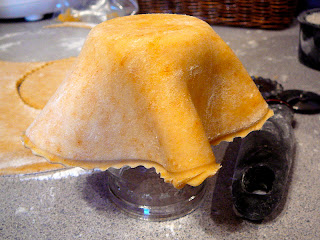One day last week before it turned cold and snowed I slipped over to out town's library and checked out a few books. One was Baking with Julia by Dorie Greenspan. I certainly marbled at what I don't know about bread baking!!!
There are such interesting recipes, I am anxious to try them all!!! On a scale this was probably the easiest. I have made hundreds if not thousands of potato rolls and maybe, just maybe a loaf of potato bread but not that neared the description of this one.
The crust is deep and dark, crisp, and the ratio of potato to flour is about 50%. The crumb is fine and tender and the rise is extremely quick yielding 2 rustic loaves.
I did modify (wouldn't you know!) the recipe by using cooked potatoes I had on hand from the evening before. I can't help it. I have that German frugal, or maybe it is the staunch Missouri Synod Lutheran, well anyway.......waste not want not......I put about a good quart of cold boiled potatoes through my food mill to rice them and measured out 3 cups after letting them come to room temperature.
Since I didn't have the potato water called for I used 1/2 cup of very warm water and dissolved about 1/2 t. of the riced potatoes in the warm water to equal what she calls for in the recipe.
The end result was 2 deep dark crisp and delicious loaves of the bread. We enjoyed a loaf with dinner and shared a loaf when my granddaughter came by to grab an onion for her Dad who was cooking their dinner last night.
Her is Julia's recipe:
1 1/2 pounds russet potatoes (about 3)
4 t. salt
1/2 C. tepid reserved potato water (80-90 degrees F)
1 T. active dry yeast
2 T. extra-virgin olive oil
4 3/4 C. unbleached all purpose flour
Wash, peel, and quarter the potatoes adding them to a lidded 2 quart pot, covering with water, and adding 2 t. salt. Boil until easily pierced with a fork. Draw off 1/2 C. of the potato water before draining the potatoes and set it aside. After draining the potatoes spread them out over a flat surface to cool and air dry for 20-30 minutes.
Stir the yeast into the cooled water (below 115 degrees as to not kill the yeast). Allow this to rest for 5 minutes; it will become creamy.
Meanwhile, turn the cooled potatoes into a mixer bowl fitted with a paddle attachment and mash them. Turn the mixer on low speed and add the dissolved yeast and the olive oil. Mix until well incorporated.
Replace the paddle with the dough hook. At low speed add the flour and the remaining 2 t. of salt. Mix on low for 2-3 minutes.
Increase the speed to medium and mix for 11 minutes more. The dough will be firm at first and soft at the finish. In the beginning it will look so very dry you will think you're making pie crust!! But as the dough is worked, it will be transformed. It may even look like a brioche, cleaning the sides of the bowl but pooling at the bottom. HAVE FAITH AND KEEP BEATING.
Cover the mixing bowl with plastic wrap and allow to rise at room temperature for 20-30 minutes. The dough will have risen noticeably but may not have doubled.
While the bread is proofing, position a rack on the bottom setting of the oven and fit it with a baking stone or quarry tiles, leaving a border of at least 1" around all sides. Preheat the oven to 375 degrees F. Place a tea towel on a baking sheet and rub it with flour. and set it aside, this will be the resting place for the breads final rise. Rub a bakers peel or baking sheet with corn meal or flour. Fill a spray bottle with water and set aside.
After the first rise is done turn the bread dough out onto a lightly floured surface and cut the dough in half. Shape each piece into a ball then flatten into a disk. Starting at the edge farthest away from you, roll the dough towards you. When you are on your last roll, stop and pull the free end towards you, stretching it gently, and dust it's edge with flour. Finish the roll and, if necessary, rock the loaf back and forth a little to taper the ends and form a torpedo, or football.
Place the loaves on the floured towel, seam side down, and cover them. Let rise at room temperature 20-30 minutes.
When you are ready to bake , spray the inside of the oven wall on all sides with the water and immediately close the oven door to trap the steam. Turn the breads out, seam side up, onto the peel and transfer them into the oven. Spray the oven with water again closing the door quickly. Bake the loaves for 45-50 minutes until the crust is very brown. The loaves should sound hollow when thumped. The most important test, the temperature should read 200 degrees F when an instant read thermometer is plunged into the center of the loaf.
Remove the bread from the oven and cool on a rack for at least 20 minutes before slicing. "Slathering this bread with butter while it is still warm is a great treat."
The breads should be stored at room temperature. Once sliced the bread should be turned cut side down on a cutting board. It will keep at room temperature for about 2 days. To store longer wrap and freeze for up to a month. Thaw still wrapped at room temperature.

















































